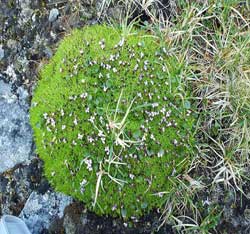Cushion plants help other plants survive

Cushion Pink (Silene acaulis) is a good example of a cushion plant, and is one of the species that was studied in Sweden.<br>Photo: Henrik Antonsson<br>
Cushion plants are a type of plant found in areas such as Arctic environments, and are characterised by their distinctive, round, cushion-like shape.
A new study highlights the strong interaction between cushion plants and other plants in the most severe of mountain environments.
“Cushion plants create additional viable living environments for other species, and are therefore important keystone species that provide the fundamental conditions required for greater biodiversity in the most extreme alpine environments,” explains Robert Björk, ecologist and researcher at the University of Gothenburg’s Department of Earth Sciences.
The studies show that these cushion plants create protective environments in the most inhospitable places for plants on earth for those species that are less tolerant to stress.
“We have shown that the more severe an environment is, the more cushion plants do to counteract the reduction in phylogenetic diversity. This relationship would not have been discovered if we not succeeded in discerning the interaction between plants.”
The researchers have studied 77 alpine plant communities on five continents. The cushion-like plant form has evolved more than 50 independent occasions in the higher plants’ evolutionary history, and can now be found in all major alpine, sub-Antarctic and Arctic regions around the world.
“If you compare the relationship between the species in the studied global species pool, cushion plants create even more phylogenetically unique plant communities the harsher the environments become, compared to the plant communities found in the adjacent open ground.”
The research has been partly financed through Biodiversity and Ecosystem services in a Changing Climate (BECC), a strategic research area initiated by the Swedish Government.
Link to the article in Ecology Letters: http://onlinelibrary.wiley.com/doi/10.1111/ele.12070/abstract
Contact:
Robert G. Björk, Department of Earth Sciences, University of Gothenburg
Telephone: +46 (0)31 786 2835, mobile: +46 (0)704 54 65 41
E-mail: robert.bjork@gu.se
Media Contact
More Information:
http://www.gu.seAll latest news from the category: Life Sciences and Chemistry
Articles and reports from the Life Sciences and chemistry area deal with applied and basic research into modern biology, chemistry and human medicine.
Valuable information can be found on a range of life sciences fields including bacteriology, biochemistry, bionics, bioinformatics, biophysics, biotechnology, genetics, geobotany, human biology, marine biology, microbiology, molecular biology, cellular biology, zoology, bioinorganic chemistry, microchemistry and environmental chemistry.
Newest articles

Properties of new materials for microchips
… can now be measured well. Reseachers of Delft University of Technology demonstrated measuring performance properties of ultrathin silicon membranes. Making ever smaller and more powerful chips requires new ultrathin…

Floating solar’s potential
… to support sustainable development by addressing climate, water, and energy goals holistically. A new study published this week in Nature Energy raises the potential for floating solar photovoltaics (FPV)…

Skyrmions move at record speeds
… a step towards the computing of the future. An international research team led by scientists from the CNRS1 has discovered that the magnetic nanobubbles2 known as skyrmions can be…





















